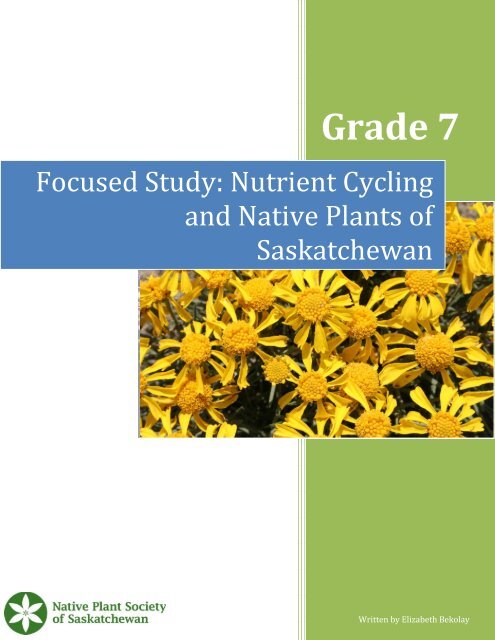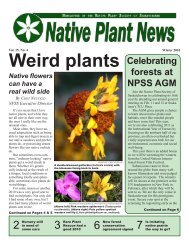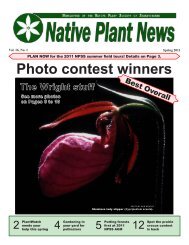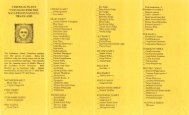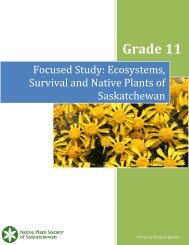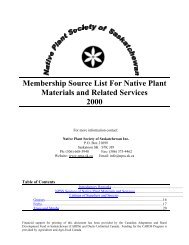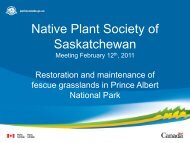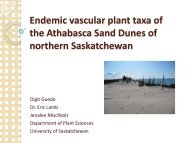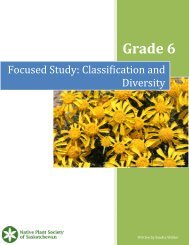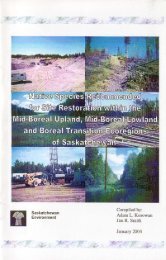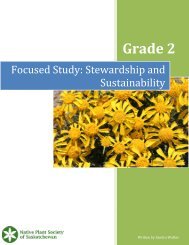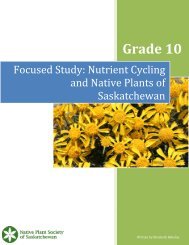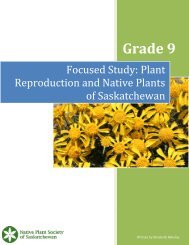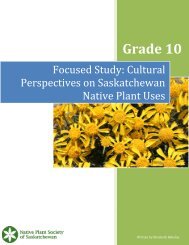Grade 7 Nutrient Cycling Lesson Plan - Native Plant Society of ...
Grade 7 Nutrient Cycling Lesson Plan - Native Plant Society of ...
Grade 7 Nutrient Cycling Lesson Plan - Native Plant Society of ...
You also want an ePaper? Increase the reach of your titles
YUMPU automatically turns print PDFs into web optimized ePapers that Google loves.
<strong>Grade</strong> 7<br />
Focused Study: <strong>Nutrient</strong> <strong>Cycling</strong><br />
and <strong>Native</strong> <strong>Plan</strong>ts <strong>of</strong><br />
Saskatchewan<br />
Written by Elizabeth Bekolay
The <strong>Native</strong> <strong>Plan</strong>t <strong>Society</strong> <strong>of</strong> Saskatchewan is a strong advocate <strong>of</strong> nature<br />
education.<br />
In addition to this lesson plan, we also support schools by:<br />
- providing free printed resources.<br />
- leading field tours.<br />
- delivering outdoor and classroom presentations.<br />
- hosting opportunities to "ask an expert", where students can interact with a pr<strong>of</strong>essional biologist or<br />
related occupation though in person events or Skype. In some cases, we can arrange for French<br />
speaking experts.<br />
We also support the establishment <strong>of</strong> native plant learning gardens on school grounds by <strong>of</strong>fering free<br />
native seeds, printed resources, personal visits, presentations and expert advice to help with all stages<br />
<strong>of</strong> the process. The gardens can be as small as a square meter.<br />
All <strong>of</strong> what we do is always free for participating schools.<br />
Does any <strong>of</strong> this sound like something you'd want? If so, please call us at (306) 668-3940 or e-mail us at<br />
info@npss.sk.ca<br />
Free Electronic Resources on the <strong>Native</strong> <strong>Plan</strong>t <strong>Society</strong> <strong>of</strong> Saskatchewan Website (www.npss.sk.ca)<br />
<br />
<br />
<br />
<br />
A Guide to Small Prairie Restoration - How to Grow Your Own Patch <strong>of</strong> <strong>Native</strong> Prairie<br />
Saskatchewan's <strong>Native</strong> Prairie: Taking Stock <strong>of</strong> a Vanishing Ecosystem and Dwindling Resource (Also<br />
available in print)<br />
On the Prairie - A webpage on our site with a "Build a Prairie" game, field guide to prairie plants and<br />
animals, curriculum goodies like a English-Dakota language guide, and virtual reality panoramas <strong>of</strong><br />
prairie places<br />
The Watershed Game<br />
Free Printed Materials Available Through the <strong>Native</strong> <strong>Plan</strong>t <strong>Society</strong> <strong>of</strong> Saskatchewan:<br />
<br />
<br />
<br />
<br />
<strong>Native</strong> <strong>Plan</strong>ts, Water and Us! (Booklet)<br />
<strong>Native</strong> <strong>Plan</strong>ts, Water and Us! (Poster)<br />
<strong>Native</strong> <strong>Plan</strong>t Communities <strong>of</strong> Saskatchewan (Poster)<br />
<strong>Native</strong> <strong>Plan</strong>t Communities <strong>of</strong> Saskatchewan (Activity Sheet)
FOCUSED STUDY: NUTRIENT CYCLING AND NATIVE PLANTS OF SASKATCHEWAN<br />
GRADE 7<br />
“WHAT GOES AROUND COMES AROUND”<br />
OVERVIEW AND PURPOSE<br />
To explore and form an understanding <strong>of</strong> the unseen forces that keep everything on planet earth alive.<br />
The air that we and all other oxygen dependant life forms breath, the energy and elements that are<br />
essential for the survival <strong>of</strong> all and the stories that we tell about these mysteries that only deepen as<br />
knowledge is shared between cultures.<br />
The students will study a local native legume in its habitat and create a piece <strong>of</strong> art that shows the<br />
cycling <strong>of</strong> nutrients and energy through the ecosystem.<br />
By focusing on one plant at a time, a relationship can be built between the student and the plant. As<br />
John Muir wrote, ‘When one tugs at a single thing in nature, he finds it attached to the rest <strong>of</strong> the<br />
world.’ When a child can focus on something in nature, something tangible that holds a story, and an<br />
adult helps to illuminate that story by asking more questions, the child can begin to see the connections<br />
on their own as a revelation <strong>of</strong> their own exploration. This is the beginning <strong>of</strong> ecological literacy.<br />
OUTCOMES AND INDICATORS<br />
IE7.3 Evaluate biogeochemical cycles (water, carbon, and nitrogen) as representations <strong>of</strong> energy flow<br />
and the cycling <strong>of</strong> matter through ecosystems.<br />
a. Model the carbon, nitrogen, and water cycles to illustrate how matter cycles through ecosystems.<br />
b. Analyze the strengths and limitations <strong>of</strong> models in science generally, and then apply these criteria to<br />
evaluate the efficacy <strong>of</strong> a student model <strong>of</strong> a biogeochemical cycle.<br />
MATERIALS<br />
The internet. Pens, pencils, paper. <strong>Plan</strong>t identification books. A camera.<br />
INTRODUCTION<br />
By this grade level a student should have a basic understanding <strong>of</strong> what a native plant is. However, it is<br />
always good to reinforce and remind. A plant native or indigenous to Saskatchewan is one that has<br />
evolved here. T his means that it was here prior to European contact. <strong>Native</strong> plants are adapted to their<br />
specific climatic zone and soil type. There are both native aquatic plants and terrestrial plants. <strong>Plan</strong>ts<br />
that are not native are considered ‘introduced’ or ‘exotic’. If these introduced species spread rapidly<br />
and out-compete other plants in an ecosystem they are considered ‘invasive’ or sometimes referred to<br />
as ‘noxious weeds’. <strong>Native</strong> plants are part <strong>of</strong> the biodiversity that help to keep our ecosystems healthy.<br />
They support a vast number <strong>of</strong> species that have evolved with them in an intricate relationship. The loss<br />
<strong>of</strong> this biodiversity has an impact throughout the ecosystem resulting in species endangerment and<br />
extinction. It is important to promote a sense <strong>of</strong> respect through ecological knowledge <strong>of</strong> place.<br />
Legumes are an important part <strong>of</strong> the Nitrogen cycle. They are plants in the family Fabaceae that<br />
produce a carpel, or pod, that opens along both sides. Familiar examples <strong>of</strong> legumes are beans, peas,<br />
lentils, and clover. These are all introduced plants, brought here for agricultural use.<br />
Before beginning the study, review the N, C and H 2 O cycles. When in the field, show examples <strong>of</strong><br />
different phases <strong>of</strong> N and C.
How do plants and bacteria work together to take N gas from the air and put it in the soil as food?<br />
The root nodules show a pink colour when<br />
they are infected with nitrogen fixing<br />
bacteria Rhizobium. Photo by Ninjatacoshell.
Some common nitrogen fixing native legumes across Saskatchewan:<br />
Thermopsis rhombifolia –<br />
Buffalo Bean or Golden<br />
Bean. Found in the prairie<br />
and aspen parkland.<br />
(Photo by Keith Barr)<br />
Line drawing from Britton, N.L., and A. Brown. 1913. An illustrated flora <strong>of</strong> the northern United States,<br />
Canada and the British Possessions.<br />
American Vetch – Vicia americana. Common<br />
through our prairies and deciduous and<br />
coniferous forest.<br />
(Photo by Walter Seigmund)<br />
Line drawing from Britton, N.L., and A. Brown. 1913. An illustrated flora <strong>of</strong> the northern United States,<br />
Canada and the British Possessions.
Psoralea esculenta - Indian Breadroot.<br />
Prairie plant. Important food plant for<br />
First Nation people.<br />
(Photo by Rheanna Kautzman)<br />
Line drawing from Britton, N.L., and A. Brown. 1913. An illustrated flora <strong>of</strong> the northern United States,<br />
Canada and the British Possessions.<br />
Purple Prairie Clover -<br />
Dalea purpurea<br />
Common prairie legume.<br />
(Photo by Candace Neufeld)<br />
Line drawing from Britton, N.L., and A. Brown. 1913. An illustrated flora <strong>of</strong> the northern United States,<br />
Canada and the British Possessions.
Image: Johann Dréo modified by Raeky<br />
INSTRUCTIONAL METHODS<br />
There is no better way to teach about nutrient cycles than by visiting<br />
a healthy functioning ecosystem. This may be more challenging for<br />
some people in Saskatchewan, particularly in the South, where vast<br />
ecosystems have been changed by human habitation.<br />
The cycles <strong>of</strong> the elements<br />
are truly magical and<br />
constant miracles.<br />
Everything is dependent on<br />
the life or cycle stages <strong>of</strong><br />
everything else.<br />
Bring your students to a local native ecosystem. In groups have them<br />
explore the area, write a description and make a sketch <strong>of</strong> the habitat,<br />
list all the plants and animals they see and choose one legume to study<br />
in-depth (review the characteristics <strong>of</strong> a legume before heading out).<br />
Make a sketch <strong>of</strong> the plant and take many pictures. Have them look at<br />
What does indigenous<br />
knowledge tell us about the<br />
earth forces that are<br />
unseen?<br />
every detail in order to help them identify it later. Or you can help them identify their plant on site if<br />
you bring an expert or native plant guides with you. The <strong>Native</strong> <strong>Plan</strong>t <strong>Society</strong> <strong>of</strong> Saskatchewan can help<br />
you to identify your species. Make detailed notes <strong>of</strong> all the other species in the area to begin to form an<br />
understanding <strong>of</strong> all the contributors to the C, N and O cycles.<br />
Knowing which ecozone you are studying will really help to narrow the possibilities <strong>of</strong> species in the<br />
search for your plant’s identity.
http://esask.uregina.ca/entry/ecozones_and_ecoregions.html<br />
Find your ecozone. Are you in<br />
the Prairie, Boreal Plain, Boreal<br />
Shield or Taiga Shield ecozone?<br />
Locate your ecoregion to<br />
narrow your plant ID search.
ASSIGNMENT:<br />
Once their plant is properly identified ask your students to write a story, poem, essay to accompany a<br />
poster or diagram <strong>of</strong> the Carbon, Nitrogen, and H 2 O cycles based on the legume and its habitat. Follow<br />
the inquiry questions below to aid in the study.<br />
INQUIRY<br />
Explore, observe, investigate, acknowledge sources, interpret, plan, and create.<br />
Questions: (These are not the essential questions to be answered; they are to help the teacher and<br />
students to explore the possibilities <strong>of</strong> what can be learned about their plant).<br />
Is this legume a native plant? (White and yellow sweet clover, red clover, alfalfa and any other crop or<br />
garden species are not native).<br />
How prevalent are legumes in this habitat?<br />
Is this plant dry loving, sun loving, or moist and shade loving? Which animals might use this plant?<br />
How?<br />
What other creatures did you see near this plant? What other roles could this plant have in the<br />
ecosystem?<br />
What role does this plant play in the N cycle? The C cycle? The O cycle?<br />
How much <strong>of</strong> the air is made up <strong>of</strong> N 2 ? How much is made up <strong>of</strong> O 2 ? CO 2 ?<br />
What is the role <strong>of</strong> solar energy in these cycles?<br />
How do other cultures view the elemental systems and cycles?<br />
ASSESSMENT<br />
Have the students share their research with each other in small groups. Invite community members to<br />
be involved in the presentations. Display the student research in a location where other students from<br />
your school can learn from it.<br />
RESOURCES<br />
Books:<br />
Aikenhead, G. and H. Michell. 2011. Bridging Cultures: Indigenous and Scientific Ways <strong>of</strong> Knowing<br />
Nature. Pearson Canada. Toronto.<br />
Grant, T. and Littlejohn, G. 2010. Greening School Grounds: Creating Habitats for Learning. New<br />
<strong>Society</strong> Publishers. Gabriola Island.<br />
Hammermeister, A., D. Gauthier and K. McGovern. 2001. Saskatchewan’s <strong>Native</strong> Prairie: Taking Stock<br />
<strong>of</strong> a Vanishing Ecosystem and Dwindling Resource. <strong>Native</strong> <strong>Plan</strong>t <strong>Society</strong> <strong>of</strong> Saskatchewan. Saskatoon.
Keane, K. and D. Howarth. 2003. The Standing People: Field Guide <strong>of</strong> Medicinal <strong>Plan</strong>ts <strong>of</strong> the Prairie<br />
Provinces. Root Woman and Dave. Saskatoon.<br />
Kershaw, L. 2003. Saskatchewan Wayside Wildflowers. Lone Pine Publishing. Edmonton.<br />
Johnson, D., L. Kershaw, A. MacKinnon, and J. Pojar. 1995. <strong>Plan</strong>ts <strong>of</strong> the Western Forest: Alberta,<br />
Saskatchewan & Manitoba Boreal Forest & Aspen Parkland. Lone Pine Publishing and the Canadian<br />
Forest Service. Edmonton.<br />
Savage, C. 2011. Prairie: A Natural History. Greystone Books. Vancouver.<br />
Vance, F.R. et al. 1999. Wildflowers Across the Prairies. Greystone Books. Vancouver.<br />
Wruck, G. and K. Gerein. 2003. <strong>Native</strong> <strong>Plan</strong>ts, Water and Us! <strong>Native</strong> <strong>Plan</strong>t <strong>Society</strong> <strong>of</strong> Saskatchewan.<br />
Saskatoon.<br />
Websites:<br />
Center for Ecoliteracy<br />
http://www.ecoliteracy.org/essays/systems-thinking<br />
The <strong>Native</strong> <strong>Plan</strong>t <strong>Society</strong> <strong>of</strong> Saskatchewan<br />
http://www.npss.sk.ca/<br />
University <strong>of</strong> Saskatchewan Herbarium Rare <strong>Plan</strong>ts Index<br />
http://www.usask.ca/biology/rareplants_sk/root/htm/en/index.php/<br />
References:<br />
Johnson, D., L. Kershaw, A. MacKinnon, and J. Pojar. 1995. <strong>Plan</strong>ts <strong>of</strong> the Western Forest: Alberta,<br />
Saskatchewan & Manitoba Boreal Forest & Aspen Parkland. Lone Pine Publishing and the Canadian<br />
Forest Service. Edmonton.<br />
Wruck, G. and K. Gerein. 2003. <strong>Native</strong> <strong>Plan</strong>ts, Water and Us! <strong>Native</strong> <strong>Plan</strong>t <strong>Society</strong> <strong>of</strong> Saskatchewan.<br />
Saskatoon.<br />
This project was undertaken with the financial support <strong>of</strong>:<br />
Ce projet a été réalisé avec l'appui financier de:


